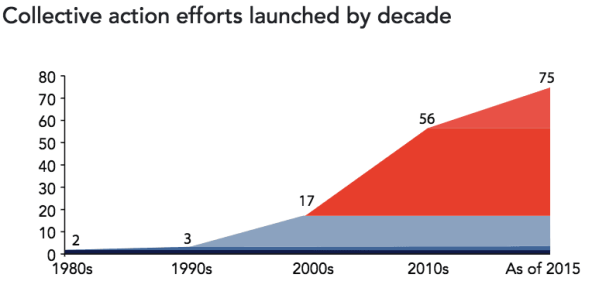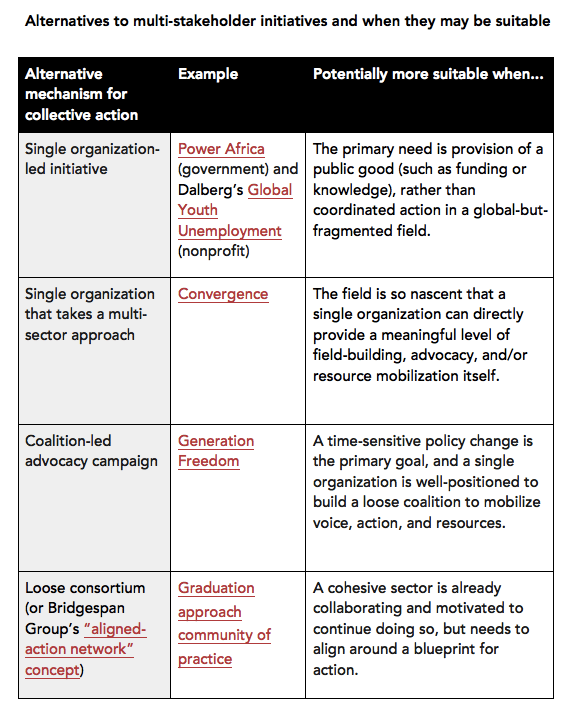The number of multi-stakeholder initiatives (MSIs) in the social impact space has increased dramatically over the past few decades, beginning in the 70s with the Consultative Group for International Agricultural Research, followed by a considerable uptick in the 90s. Known by many names—including coalitions, public-private partnerships, and alliances—these types of organizations naturally appeal to those seeking transformative change. They offer a powerful model to solve increasingly complex global development problems, particularly because they bring together stakeholders across sectors, influence ecosystems, and create impact at meaningful scale.

Since our founding, our team at the Global Development Incubator has worked to build and advise MSIs, including the Aspen Network of Development Entrepreneurs, the Better Than Cash Alliance, and the Consultative Group to Assist the Poor.
Our recent study, “More than the Sum of Its Parts: Making MSIs Work,” attempts to distill MSI launch best practices from research and interviews with more than 30 early MSI funders and implementers. Our initial plan was to provide a how-to guide for practitioners and funders interested in the model, but as we discussed our findings with the report’s advisory committee comprised of donor representatives, we quickly realized that we were getting ahead of ourselves. To truly build a discipline around developing MSIs, we needed to answer one critical question before digging into the “how”: Should you launch one in the first place?
At their core, MSIs are risky startup ventures. All too often, donors and organizations with the best of intentions show over-enthusiasm for starting them because the model has worked elsewhere—albeit with different problems and different partners. But in addition to requiring significant time and financial investments, MSIs’ achievements often fall short of expectations. (Our interviewees gave their MSIs on average a C grade ranking on performance against founding objectives.) At minimum, new MSIs are entering already crowded, competitive fields—meaning they need to prove their value to the field from day one.
Are you enjoying this article? Read more like this, plus SSIR's full archive of content, when you subscribe.
Given the risk involved, we identified three important questions that can help donors and practitioners assess whether they should set up an MSI:
- Alignment: Are your objectives aligned with effective MSI goal areas? Our research found that MSIs are effective in three primary areas: industry and market development, policy and political support, and resource mobilization and optimization.
- Suitability: Is a new MSI the best kind of intervention to address the mandate? MSIs are most suitable when the scope of the effort is multi-country, multiple sectors need to coordinate, and the field of actors is highly fragmented. If only some of these are true, organizations should explore less risky and/or less costly alternatives.
- Prospects: Is this MSI likely to succeed? MSIs need to launch in a favorable environment. Sometimes success hinges on timing. (Is there an urgent need for the MSI? Is this a burgeoning field? Is there a galvanizing event to leverage?) Other times, it may be a matter of having the right people in place, such as an anchor funder, interim owner, or specific initial participants.
One example of an MSI that ticked all of the right boxes is the Alliance for Affordable Internet (A4AI). A4AI’s mandate targeted all three goal areas, and launched at time when there was widespread and growing interest in how increased connectivity could influence development outcomes. A4AI also had the right people on board. It successfully leveraged its association with the US Department of State, secured USAID as an anchor funder, and selected legitimacy-building early participants—including from the private sector. All of this increased its likelihood of success. A4AI was the youngest MSI in our sample but appears to be on a very promising trajectory.
If not an MSI, then what?
We’ve seen a lot of appetite for direction on what to do when the answer is “no”—in other words, what alternatives can funders and practitioners consider when an MSI is not a suitable intervention? This question was outside the scope of our original research but is an important question we are starting to explore in our day-to-day work with innovators. It’s relevant not only at the startup stage, but also at what we call the “sunset” stage; when an MSI has achieved its original mandate or can continue its work in a less resource-intensive manner, what should it become? (Our article, “What’s Your Endgame,” explores this question as it relates to nonprofits.)
We’ve identified a preliminary set of alternatives to MSIs, examples of them in action, and situations when other mechanisms may be better suited than an MSI. In general, these are lighter-touch and/or less resource-intensive approaches—in terms of both financial resources and intangibles like time and political will:

MSIs, in the right context and if set up well, can be a powerful tool to tackle some of the most critical challenges that we face today. But would-be funders and founders of MSI must take the time to carefully consider other alternatives that might be less time-intensive and complex to establish than an MSI, and learn from the past experiences of other MSIs, before jumping in. As we heard loud and clear from our interviews with 17 MSIs, often the “whether” question is just as important as the “how.”
Support SSIR’s coverage of cross-sector solutions to global challenges.
Help us further the reach of innovative ideas. Donate today.
Read more stories by Darin Kingston, Joanne Ke & Andrew Stern.

